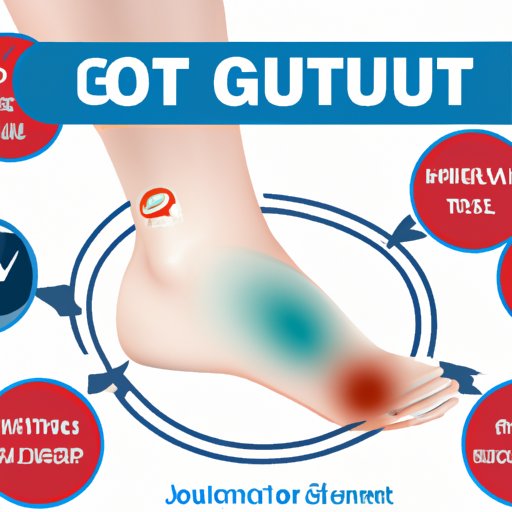Introduction
Gout is a common form of arthritis that affects millions of people around the world. It’s caused by a buildup of uric acid in the body, which can lead to painful swelling and inflammation in the joints. If you’ve ever experienced a gout attack, you know how debilitating and painful it can be. But recognizing the symptoms of gout early and seeking medical attention can help you manage your symptoms effectively.
The purpose of this article is to provide a comprehensive guide to gout symptoms, including how to recognize them and manage them. Whether you’re someone who has already been diagnosed with gout or someone who suspects you may have it, this guide will provide you with the information you need to navigate this condition.
Understanding Gout: Symptoms, Causes, and Treatment Options
Gout is caused by elevated levels of uric acid in the body, which can form crystals in the joints. These crystals can lead to painful swelling and inflammation, which is what causes gout symptoms.
While gout can be caused by a variety of factors, including genetics and lifestyle factors, there are several common causes that contribute to the condition. These can include eating foods high in purines, being overweight or obese, having high blood pressure or diabetes, and taking certain medications.
Treatment options for managing gout can include lifestyle changes, such as eating a healthy diet and losing weight, as well as medications like nonsteroidal anti-inflammatory drugs (NSAIDs) and corticosteroids. In severe cases, doctors may recommend surgery to remove the crystals from the joints.
Could You Have Gout? Recognizing the Symptoms and Seeking Diagnosis
Recognizing the symptoms of gout early is crucial for managing the condition effectively. Some of the most common symptoms of gout include:
– Sudden onset of intense joint pain
– Swelling or inflammation in the joint
– Redness or warmth in the joint
– Limited range of motion in the joint
– Tenderness or stiffness in the joint
If you suspect that you may have gout, it’s important to seek medical attention as soon as possible. Your doctor will likely perform a physical exam and order blood tests to check your uric acid levels. They may also order X-rays or ultrasounds to look for signs of joint damage.
From Swelling to Pain: Identifying the Signs of Gout
Gout attacks can vary in severity and presentation, making them difficult to diagnose. However, there are several signs and symptoms that are commonly associated with gout.
In addition to sudden onset of intense joint pain, other signs of a gout attack can include:
– Swelling or inflammation in the joint
– Redness or warmth in the joint
– Limited range of motion in the joint
– Tenderness or stiffness in the joint
Gout attacks can also be accompanied by other symptoms, such as fever, fatigue, and rapid heartbeat. These symptoms are typically less common and may indicate a more severe form of gout.
How to Tell if You Have Gout: Recognizing the Symptoms
If you suspect that you may have gout, it’s important to pay attention to your symptoms and seek medical attention if necessary. Some of the most common symptoms of gout include:
– Sudden onset of intense joint pain: This pain can be severe and usually occurs in the big toe, although it can also occur in the ankles, knees, elbows, wrists, or fingers.
– Swelling or inflammation in the joint: This can be accompanied by redness, warmth, and tenderness in the affected area.
– Limited range of motion in the joint: You may find it difficult to move the affected joint, which can affect your mobility.
– Tenderness or stiffness in the joint: The affected joint may feel sore or stiff, particularly in the morning or after periods of inactivity.
The Top 5 Symptoms of Gout: What You Need to Know
While gout can present in a variety of ways, there are several key symptoms that are particularly important to watch for. These include:
1. Sudden onset of intense joint pain: This can come on quickly and may be severe enough to wake you up at night.
2. Swelling or inflammation in the joint: This can be accompanied by redness, warmth, and tenderness in the affected area and may make it difficult to move the joint.
3. Limited range of motion in the joint: You may find it difficult to move the affected joint, which can affect your mobility.
4. Tenderness or stiffness in the joint: The affected joint may feel sore or stiff, particularly in the morning or after periods of inactivity.
5. Recurring episodes of gout: Once you’ve had a gout attack, you’re more likely to experience additional episodes in the future.
Gout Symptoms: A Comprehensive Guide for Diagnosis and Management
In summary, recognizing the symptoms of gout early and seeking medical attention is crucial for managing this condition effectively. If you suspect that you may have gout, pay attention to your symptoms and seek medical attention as soon as possible.
If you’ve already been diagnosed with gout, there are several things you can do to manage your symptoms effectively. These can include making lifestyle changes like eating a healthy diet and losing weight, taking medications, and avoiding triggers that can cause gout attacks.
Remember, managing gout is all about prevention and early intervention. By recognizing the symptoms of gout early and taking steps to manage your condition, you can reduce your risk of complications and improve your quality of life.
Conclusion
In conclusion, gout is a common and debilitating condition that affects millions of people around the world. Recognizing the symptoms of gout early and seeking medical attention is crucial for managing this condition effectively.
If you suspect that you may have gout, don’t wait to seek medical attention. By working closely with your doctor and adopting healthy lifestyle habits, you can successfully manage your symptoms and improve your quality of life.
